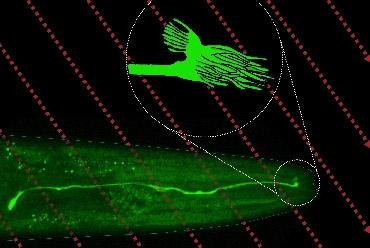Illinois State University’s Andres Vidal-Gadea is leading the way to understanding the internal compass of animals by identifying the first sensor of the Earth’s magnetic field in the brain of a worm.
Researchers have known for years that animals such as geese and sea turtles use the Earth’s magnetic field to navigate long distances in migration. What they have not understood – until now – is how it works.
“So much around us generates a magnetic field, and we interact with that. If we could see it, it would look like a Van Gogh painting with fields swirling like Starry Night,” said Vidal-Gadea, an assistant professor of molecular neuroethology, who led a research team at the University of Texas at Austin under the mentorship of Jon Pierce-Shimomura before he arrived at Illinois State in January. “We have known that animals have a set of magnetic beads that act like the needle of a compass, but what we did not know is how the brain senses it. We did not know what the magnetic receptor looked like.”
Vidal-Gadea discovered the sensor in tiny worms called C. elegans. The worms, which only reach 1 millimeter in length, possess an antenna-like structure that allows them to navigate through the soil. “There are a lot of critters in the soil that use magnetic fields to do vertical migrations,” he said. “Now we have a better idea how they do it.”
The miniscule C. elegans only possesses 302 neurons, making it ideal for research.
The team found the sensor in a neuron that had been well studied. “This same neuron detects carbon dioxide and soil temperature for the worms, so it makes sense that it is also the magnetic receptor in what amounts to a depth perceptor,” said Vidal-Gadea.
The research was recently published in the journal eLife. In the article, researchers discuss how they discovered that hungry worms in gelatin-filled tubes tend to move down, a strategy they might use when searching for food. When the researchers brought worms into the lab from other parts of the world, the worms didn’t all move down. Depending on where they were from — Hawaii, England, or Australia, for example — they moved at a precise angle to the magnetic field that would have corresponded to down if they had been back home.
Labs around the globe have been racing to be the first to find the receptor. With the discovery, Vidal-Gadea takes the lead worldwide on the frontiers of neuroethology – or the study of how animal behavior is linked to the nervous system. Now that he is part of the Illinois State faculty, he will continue his research here. He will continue to study the worms on a molecular level to understand how the magnetic field works with cell proteins. “This could unlock the key to how all animals migrate,” he said.
Support for this research came from the National Institutes of Health and the National Institute of Neurological Disorders and Stroke. The University of Texas at Austin contributed to this story.
Vidal-Gadea can be reached via MediaRelations@IllinoisState.edu.


